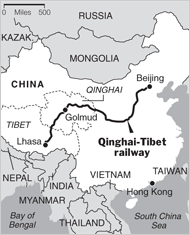Last Stop Lhasa: Rail Link Ties Tibet to China

-- Mao's "Vision" a Reality;
-- Chinese Control Publicity;
-- "Fight to the Death" vs. HHDL
By Joseph Kahn, The New York Times
BEIJING, July 1 — This weekend, China opened the world's highest railway, a 710-mile line that crosses the vertiginous Tibetan Plateau and forges a steel bond with the once-secluded Buddhist holy city of Lhasa.
The railway, inaugurated on Saturday by President Hu Jintao and top Communist Party cadres on a deluxe opening run, is an engineering marvel that traverses unstable permafrost and reaches more than 16,000 feet above sea level, higher than Mont Blanc in France.
Party officials have hailed the $4.1 billion project, which was decades in the making, as a milestone in its efforts to develop its vast, poor western region and bring an infusion of people and prosperity to remote Tibet.
But Tibetan and foreign critics say that the railway benefits Han Chinese, China's dominant ethnic group, at the expense of Tibetan natives. They argue that enhanced transportation links will accelerate a trend of Han-led economic development and smother Tibet's ancient spiritual culture, while undermining the pristine natural environment of its highlands.
"The overwhelming opinion among Tibetans is that the railway will consolidate Chinese control and bring in huge numbers of Han Chinese," said Tenzin Tsundue, an independent Tibetan writer who lives in India. "It will mean less employment and more destruction for Tibetans, not more opportunity."
On Friday, three women from the United States, Canada and Britain were detained briefly after they climbed through a second-floor window at Beijing's main train station and unfurled a black-and-white banner that read, "China's Tibet Railway, Designed to Destroy."
Chinese officials defend the railway as vital to stimulating Tibet's development. They project it will double tourist revenues and reduce the cost of cargo transport by up to three-fourths.
"The completion of the Qinghai-Tibet railway is a significant piece of good news longed for by the people in Qinghai Province and the Tibetan Autonomous Region," Zhu Zhensheng, executive vice director of the Qingzang Railway Office of the Chinese Railway Administration, said in a news briefing this week. "The railway provides capacity for the quick flow of people, goods and information and will directly contribute to the development" of the area.
Mao proposed extending a railway to Tibet after the People's Liberation Army invaded the territory and brought it firmly under Chinese control in 1951, sending the Dalai Lama, Tibet's spiritual leader, into exile.
The first section, from Beijing to Golmud in Qinghai Province, was completed in 1984.
But the 710-mile section connecting Golmud to Lhasa was delayed indefinitely. That section had to cross the Tibetan Plateau, survive extreme temperatures and stay fixed in the shifting permafrost of the highlands.
The plan was revived in 2001, when it was promoted as a crucial element of the Communist Party's "Go West" campaign. Engineers designed bridges to span the most treacherous area of permafrost and sank naturally cooled piping into the ground to keep the track bed frozen year-round, reducing instability.
Canada's Bombardier Inc. supplied specially outfitted train carriages that have artificial oxygen, like that used in aircraft, to prevent sickness among passengers at high altitudes.
A direct Beijing-to-Lhasa luxury train was officially unveiled Saturday to coincide with the 85th anniversary of the founding of the governing Communist Party. State news media have been promoting the train for weeks as a new feather in the cap of state engineers who also celebrated the formal completion of the Three Gorges Dam, the world's largest dam, this spring.
But the event is being tightly controlled by Chinese officials to ensure favorable coverage. They handpicked 40 foreign journalists to ride the first train. Other news organizations, including The New York Times, that bought train tickets independently were denied requisite permits to enter Tibetan territory.
Even at the official price of $4.1 billion, the railway is hard to justify in economic terms alone. Tibet's total gross domestic product in 2005 was $3.12 billion, so the payoff for the railway in terms of lifting economic activity would appear to lie decades in the future, if it ever comes.
Moreover, foreign engineers who have been involved with elements of the project, but asked not to be identified because they did not wish to offend their Chinese sponsors, say the railway will require heavy expenditures on maintenance and may be hard to run for more than a decade without an extensive overhaul.
Tibetans who have voiced reservations say they do not oppose the railway in principle but argue that it was conceived mainly to enhance China's economic and military control over the Tibetan region. They say it will also aid Chinese exploitation of mineral resources in the Tibetan highlands.
They say Chinese investment in other vital infrastructure, like roads to connect Tibetan towns and electrification of rural villages, remains a lower priority.
Even as they promote the rail line, Chinese officials still focus heavily on combating what they call Tibetan separatism, especially the resilient loyalty there to the Dalai Lama.
Zhang Qingli, who was recently appointed as the Communist Party's top official in Tibet, told party leaders there in May that they were engaged in "a fight to the death" against the Dalai Lama, according to The Tibet Daily.
(Article and map copyright 2006, The New York Times)

<< Home